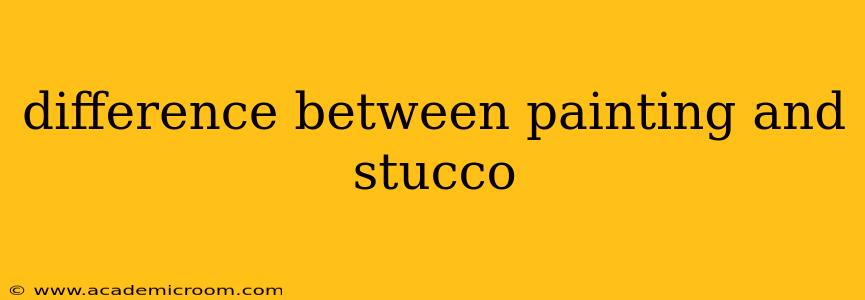Painting and stucco are both popular choices for enhancing the exterior and interior of buildings, but they differ significantly in their composition, application, and overall aesthetic. Understanding these differences is crucial for making informed decisions about your home improvement projects. This comprehensive guide delves into the key distinctions between painting and stucco, answering common questions to help you choose the right option.
What is Painting?
Painting involves applying a thin layer of pigmented liquid (paint) to a surface. This layer adheres to the underlying material, providing color, protection, and aesthetic enhancement. Paints are available in various types, including oil-based, water-based (latex), and specialized formulations for different surfaces (wood, metal, etc.). The application process is relatively straightforward, typically involving brushes, rollers, or sprayers. Painting is generally a less expensive and more easily repairable option compared to stucco.
What is Stucco?
Stucco is a durable, protective exterior wall covering composed of cement, sand, lime, and water. It's applied as a wet mixture and hardens to create a smooth or textured surface. Stucco offers superior weather resistance and durability compared to paint, making it an ideal choice for exterior walls. It's known for its longevity and ability to withstand harsh weather conditions, including rain, snow, and extreme temperatures. However, stucco application is more complex and requires skilled labor, resulting in a higher initial cost.
What are the Key Differences Between Painting and Stucco?
The differences between painting and stucco extend beyond their basic compositions. Here's a breakdown of the key distinctions:
Material Composition:
- Painting: Primarily composed of pigments, binders (e.g., oils, acrylics), and solvents.
- Stucco: A cementitious mixture of sand, cement, lime, and water.
Application Method:
- Painting: Applied with brushes, rollers, or sprayers; relatively simple application.
- Stucco: Applied as a wet mixture by skilled professionals; requires more intricate techniques.
Durability and Longevity:
- Painting: Less durable; needs repainting every few years depending on the exposure and quality of paint.
- Stucco: Highly durable and long-lasting; can last for decades with proper maintenance.
Cost:
- Painting: Generally less expensive, especially for labor.
- Stucco: More expensive due to material costs and skilled labor requirements.
Maintenance:
- Painting: Requires regular repainting and occasional cleaning.
- Stucco: Requires less frequent maintenance, primarily cleaning and occasional repairs.
Aesthetic Options:
- Painting: Offers a wide array of colors and finishes.
- Stucco: Offers various textures, but color options are typically limited to the pigment added during mixing.
Weather Resistance:
- Painting: Offers some protection from the elements, but its effectiveness depends on the type of paint used.
- Stucco: Provides excellent protection from rain, snow, and temperature fluctuations.
How Do I Choose Between Painting and Stucco?
The best choice between painting and stucco depends on several factors:
- Budget: Painting is generally more affordable.
- Durability Needs: Stucco offers superior longevity and weather resistance.
- Aesthetic Preferences: Painting provides greater color and finish variety.
- Climate: Stucco is better suited for harsh climates.
- Existing Surface: Painting can be applied to various surfaces, while stucco typically requires a specific substrate.
What is the best material for exterior walls?
The "best" material depends entirely on individual needs and preferences. Stucco offers superior durability and weather protection, making it suitable for climates with extreme weather conditions. However, it's more expensive and requires specialized labor. Painting is a more cost-effective option, offering a wide range of aesthetic choices, but requires more frequent maintenance. Factors like budget, desired longevity, and climate should guide your decision.
Is stucco better than paint for a house?
Whether stucco is "better" than paint depends on your priorities. Stucco wins in terms of durability, weather resistance, and longevity. Paint provides greater flexibility in color and design at a lower initial cost. It's not a matter of superiority but rather a choice based on specific needs and preferences.
Can you paint over stucco?
Yes, you can paint over stucco. However, proper preparation is essential for achieving a long-lasting and aesthetically pleasing result. This involves cleaning the stucco surface, repairing any cracks or damage, and applying a primer suitable for stucco before painting.
Which is easier to repair: paint or stucco?
Paint is significantly easier and less expensive to repair. Minor paint damage can typically be addressed with touch-ups. Stucco repairs, especially for larger cracks or damage, require more skill and labor.
By carefully considering these factors, you can make an informed decision that best meets your specific requirements and ensures the longevity and aesthetic appeal of your project.
